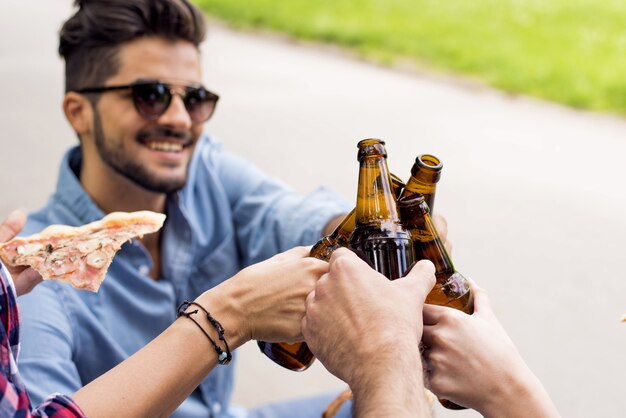How Long Can You Keep Beer Fresh in the Fridge?
Whether you're a craft beer connoisseur or a casual drinker, understanding how long your favorite brew lasts in the refrigerator is key to enjoying it at its best. Keeping beer fresh involves balancing temperature, storage techniques, and understanding the type of beer you have on hand. Let's dive into the essentials of beer storage, explore related subtopics, and equip you with practical tips to maintain that perfect sip.
🍻 The Basics of Beer Shelf Life
The shelf life of beer depends largely on its type, packaging, and storage conditions. Here's a quick breakdown:
Unopened Beer:
- Canned or Bottled Beer: Typically lasts about 6-9 months past the printed expiration date, though this may vary based on brewing methods and preservatives.
- Craft Beer: Freshness is key, often best consumed within 3-6 months depending on the brew. Many brewers provide a "best-by" date reflecting this.
Opened Beer:
- Refrigerated: Typically stays fresh for 1-2 days. The introduction of air negatively impacts flavor, carbonation, and freshness.
🕰 Factors Influencing Beer Freshness
1. Beer Type 🏷️
Different beer styles have varying shelf lives. Heavier, darker beers like stouts and porters are more durable over time compared to light ales or lagers, which degrade quicker. Beers with higher alcohol content generally last longer due to their preservative qualities.
2. Storage Temperature 🌡️
Proper storage temperature profoundly influences beer shelf life. Refrigeration slows down the aging process, keeping beers, especially lagers and IPAs, fresher for longer. Aim for a consistent temperature between 45-55°F (7-13°C) for optimal results.
3. Light Exposure ☀️
Light, particularly UV rays, can cause beer to "skunk," producing an off-flavor and aroma. This is especially true for beers in clear or green bottles. Storing beer away from light sources, particularly direct sunlight, is critical.
4. Packaging Material 🚛
- Cans: Provide a complete barrier against light and oxygen, often extending the freshness compared to bottles.
- Bottles: Dark-colored ones (brown) offer better protection than clear or green variants.
🎯 Practical Tips for Storing Beer
To maximize freshness, use these strategies:
- Purchase beer fresh and plan consumption based on storage capabilities.
- Keep beer upright to reduce oxidation and contamination.
- Avoid frequent temperature changes, which can degrade beer quality.
- Use by the "best by" date as a guide but not a strict deadline. Your senses are excellent tools; if it smells or tastes off, it probably is.
🍻 Ensuring Freshness After Opening
When a beer is opened, increase its lifespan by:
- Re-sealing with a stopper or cap to limit exposure to air.
- Storing back in the fridge quickly to preserve carbonation.
Summary: Key Takeaways & Practical Tips
- 🍺 Beer Beginnings: Enjoy unopened canned or bottled beers within 6-9 months; craft brews within 3-6 months for optimal taste.
- 🌡️ Chill Wisely: Store between 45-55°F, away from temperature fluctuations and direct light.
- 🚫 Avoid Sunlight: Skunking occurs due to light exposure; cans and dark bottles shield better.
- ♻️ Open Carefully: Opened beer stays fresh for 1-2 days; seal and refrigerate to extend life.
- ✅ Check Senses: Trust taste and smell to guide freshness post-expiry.
🌐 The Bigger Picture on Beer Storage
Storing beer isn't just about keeping it cold. It's about respecting the craftsmanship that goes into every brew. Let’s explore how storage interacts with other factors in beer enjoyment.
Complementary Considerations:
1. Aging Beer: A Specialty Approach 🗓️
Not all beers are consumed fresh. Some, like those with high alcohol content, are intentionally aged:
- Ideal for Stouts, Barleywines, Lambics: These beers can develop more complex flavors over time.
- Storage Method: Keep at cellar temperatures, around 55°F, in a dark place. Aging beer requires patience, and not all brews benefit from it.
2. Home Brewing Insights 🏡
For homebrewers, storage knowledge is doubly important to maintain quality from keg to bottle:
- Sanitation is Key: Prevent spoilage and contamination upfront.
- Homebrew Lifespan: Generally shorter shelf life; consume within a few months.
🍺 Understanding Expiry Dates
While “best-by” dates are useful, they're guidelines rather than gospel. Experiencing slightly expired beer can sometimes still be pleasant, although less vibrant. Here's how to interpret these dates:
- Production vs. Best-By Date: Manufacturers may use different terms to indicate when the beer's quality might start to decline.
🚀 Making the Most of Your Brew
To fully appreciate your beer, consider:
- Pairings: Match beer with complementary foods to enhance flavors.
- Glassware: Certain glasses enhance the aroma and taste experience.
- Temperature Service: Serve beer at the advised temperature for the style.
For instance, lagers are generally served colder than ales to sharpen their refreshing qualities, whereas stouts may benefit from a slight warmth to release their rich aromas.
Final Thoughts
Maintaining the freshness of beer isn't overly complicated, but it does require attention to detail across various storage dimensions. Whether you're preserving a beloved craft IPA or a set of your favorite lagers for an upcoming party, understanding these details helps ensure optimal taste and experience. By respecting expiration guidelines while applying your senses, you're both conserving quality and respecting the art of brewing—with each refreshing sip. 🍻
